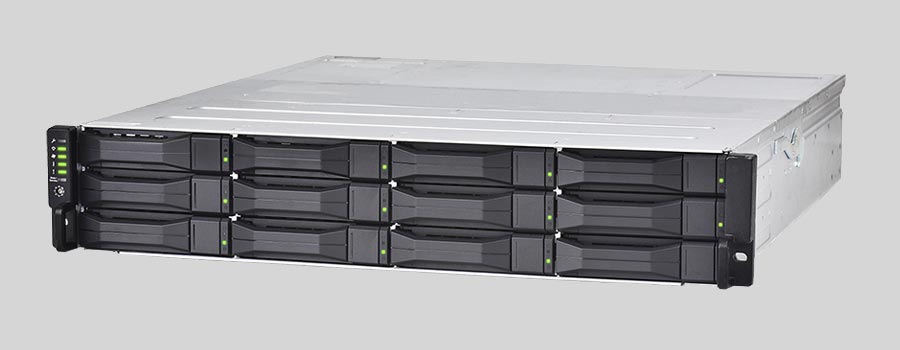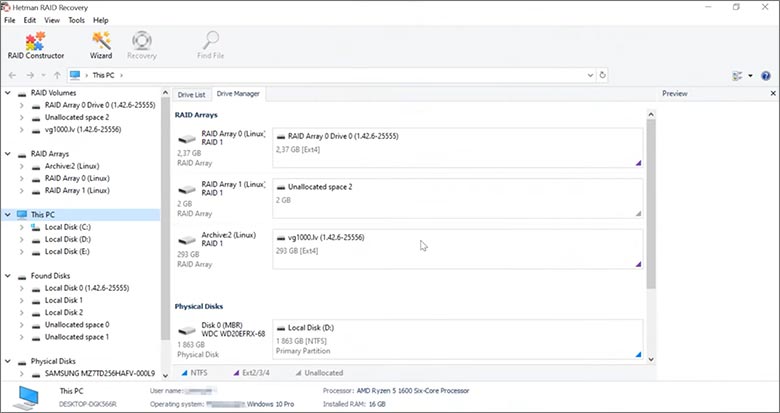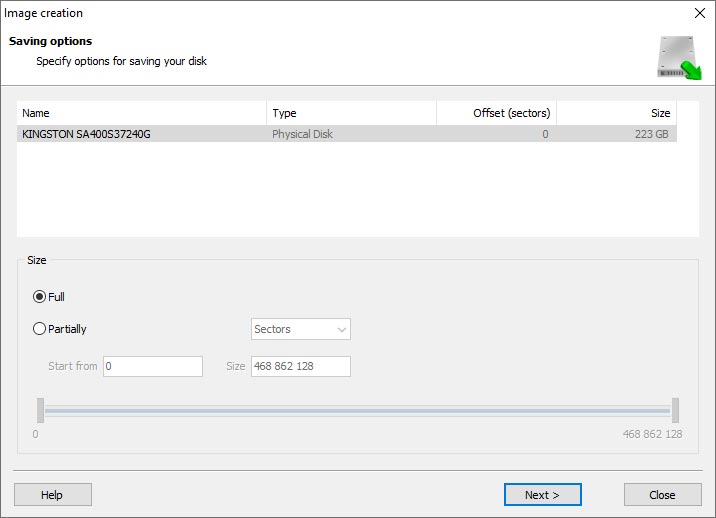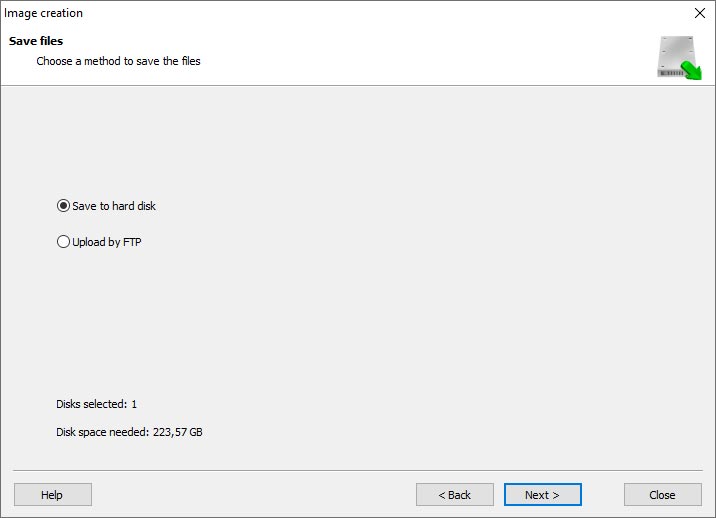
- Why Regular Data Recovery Tools Can’t Restore Files from RAID
- Key Information About the NAS Infortrend JB 312
- How to Remove Hard Disks from Your NAS and Connect Them to a PC
Why Regular Data Recovery Tools Can’t Restore Files from RAID
Conventional hard drives store user data by writing it sequentially across the disk surface, which means an entire file is typically located on a single drive. In contrast, when data is written to a RAID array, each file is split into multiple fragments. These fragments are then distributed and written in sequence across all the drives in the array. Depending on the configuration, fragment sizes can range from 2 KB to 2 MB, so every file is physically stored across several disks at once.
This approach significantly increases read and write performance — after all, writing two halves of a 1 GB file to two drives simultaneously is much faster than writing the full 1 GB to a single disk. However, this same mechanism makes file recovery far more complex.
Different RAID levels use different methods to distribute and protect data. On top of that, manufacturers like Infortrend often add their own proprietary structures and variations. As a result, data can be written to disks in many different formats, and each requires a specific approach during recovery.
How can regular software updates and patches enhance the security and stability of NAS Infortrend JB 312 devices?
Regular software updates and patches can enhance the security and stability of NAS Infortrend JB 312 devices in several ways:
- Security Vulnerability Fixes: Software updates and patches often include fixes for known security vulnerabilities. By regularly updating the software on the NAS device, you can ensure that any identified security weaknesses are addressed, reducing the risk of unauthorized access or data breaches.
- Bug Fixes: Updates and patches also address software bugs and stability issues. By applying these updates, you can improve the overall performance and reliability of the NAS device, reducing the chances of system crashes or data corruption.
- Feature Enhancements: Software updates may introduce new security features or improvements to existing security mechanisms. These enhancements can strengthen the overall security posture of the NAS device, providing better protection against potential threats.
- Compatibility with New Technologies: Updates and patches often ensure compatibility with new technologies, protocols, or devices. This ensures that your NAS device can work seamlessly with the latest security standards and protocols, keeping your data safe from emerging threats.
- Compliance with Industry Standards: Regular updates help ensure that your NAS device remains compliant with industry security standards and regulations. Compliance is crucial for organizations that handle sensitive data and need to meet specific security requirements.
- Response to Emerging Threats: Cyber threats are constantly evolving, and new vulnerabilities are discovered regularly. By keeping your NAS device up to date, you are more likely to have protection against the latest threats, as software updates often include security patches to address these new vulnerabilities.
It is essential to regularly check for updates and patches from the manufacturer and apply them promptly to ensure the security and stability of your NAS Infortrend JB 312 devices.
How to Remove Hard Disks from Your NAS and Connect Them to a PC
Although the NAS JB 312 can be accessed over the network, you still need to remove its hard disks and connect them directly to a Windows PC. Only then can the recovery software properly scan and analyze the drives. Follow these steps:
-
Power off the NAS and disconnect it from the power source.
WARNING! Before removing any drives, carefully read the device manual. Improper actions may damage both the NAS enclosure and the hard disks in the RAID array.
-
Remove the hard disks one by one, gently sliding each drive out of its slot. Remember that hard disks are highly sensitive: any impact or drop can cause serious physical damage.
-
Label each hard disk according to its position inside the NAS. The order of the drives is crucial for correct RAID reconstruction.
-
Connect the drives to your computer. In this video, we explain which ports you can use to connect hard disks and what to do if your PC does not have enough free connectors.
Go to view
Step-by-Step Data Recovery with Hetman RAID Recovery

This program restores data from damaged RAID arrays and is fully compatible with Infortrend JB 312. Each hard disk in the array contains technical metadata describing how files were written. When launched, Hetman RAID Recovery analyzes this metadata, automatically reconstructs the damaged array, and provides access to its contents. After that, you can browse the recovered disk and save your files. The program can also restore files that were accidentally deleted from the network drive.

How to recover data from a Infortrend
JB 312 has 12 HDD slots, and it supports the following array types:
- RAID 0;
- RAID 1;
- RAID 5;
- RAID 6;
- RAID 50;
- RAID 60;
- JBOD;
NAS supports:
- exFAT, VFAT, FAT 12 / 16 / 32;
- NTFS / ReFS;
- APFS / HFS+;
- Ext2 / 3 / 4 / ReiserFS / XFS / UFS / ZFS / Btrfs;
- VMFS / HikvisionFS;
How to Safely Recover Data from Disk Images
This utility allows you to create a complete copy of a disk and work with the disk image instead of the physical drive. This approach helps protect your data from:
- Overwriting during the recovery process;
- Additional data loss caused by bad sectors;
- User errors.
To create a disk image, follow these steps:
-
Ensure you have enough free space to store the image. Its size will typically match the size of the original disk.
-
In the main window, select the target disk and choose Tools - Save Disk. You can also select multiple disks if needed.
-
When the Image Creation Wizard opens, select whether you want to save the entire disk or only a specific region. Adjust the settings and click Next.

-
Choose the directory where the image will be saved. You may select any available disk connected to your PC or upload the image via FTP.

Where Are the User’s Files Actually Stored?
The Infortrend JB 312 network-attached storage keeps OS Linux operating system files on a separate RAID 1 (mirrored) array. Usually, all NAS systems create several volumes on every hard disk, and the first of them takes up to 2 Gb of space. This is where operating system files are stored. Other volumes are united into a RAID array where user’s data is written.
RAID Recovery Software: Detailed Comparison
| Product | Operating system | RAID controller support | Supported file systems | Virtual RAID controller support | Data recovery from damaged RAID | File preview |
|---|---|---|---|---|---|---|
| Hetman RAID Recovery | Windows, Linux, MacOS | Yes, over 100 controllers | FAT, exFAT, NTFS, ReFS, APFS, HFS+, Ext4, Ext3, Ext2, ReiserFS, Btrfs, VMFS, Hikvision, XFS, UFS, ZFS | Yes | Yes | Yes |
| DiskInternals RAID Recovery | Windows | Yes, over 10 controllers | FAT, NTFS, Ext2/3/4, HFS+ | No | Yes | Yes |
| R-Studio | Windows, Mac, Linux | Yes, over 20 controllers | FAT, NTFS, Ext2/3/4, HFS+ | Yes | Yes | Yes |
| UFS Explorer RAID Recovery | Windows, Mac, Linux | Yes, over 100 controllers | FAT, NTFS, Ext2/3/4, HFS+ | Yes | Yes | Yes |
| EaseUS Data Recovery | Windows | Yes, over 20 controllers | FAT, NTFS, Ext2/3/4, HFS+ | No | Yes | Yes |
| ReclaiMe Free RAID Recovery | Windows | Yes, over 100 controllers | FAT, NTFS, Ext2/3/4, HFS+ | Yes | Yes | Yes |




Yes, it is possible to recover data from a NAS device that has been affected by a hardware RAID controller failure. However, the process can be complex and may require the assistance of a professional data recovery service.
In such cases, the failed RAID controller needs to be replaced or repaired before the data can be accessed. Once the controller is functional again, the data recovery process typically involves reconstructing the RAID array and extracting the data from the disks.
It is important to note that attempting data recovery on your own or using inexperienced services can potentially lead to further data loss. Therefore, it is recommended to seek the help of a reputable data recovery service with experience in RAID systems and NAS devices.